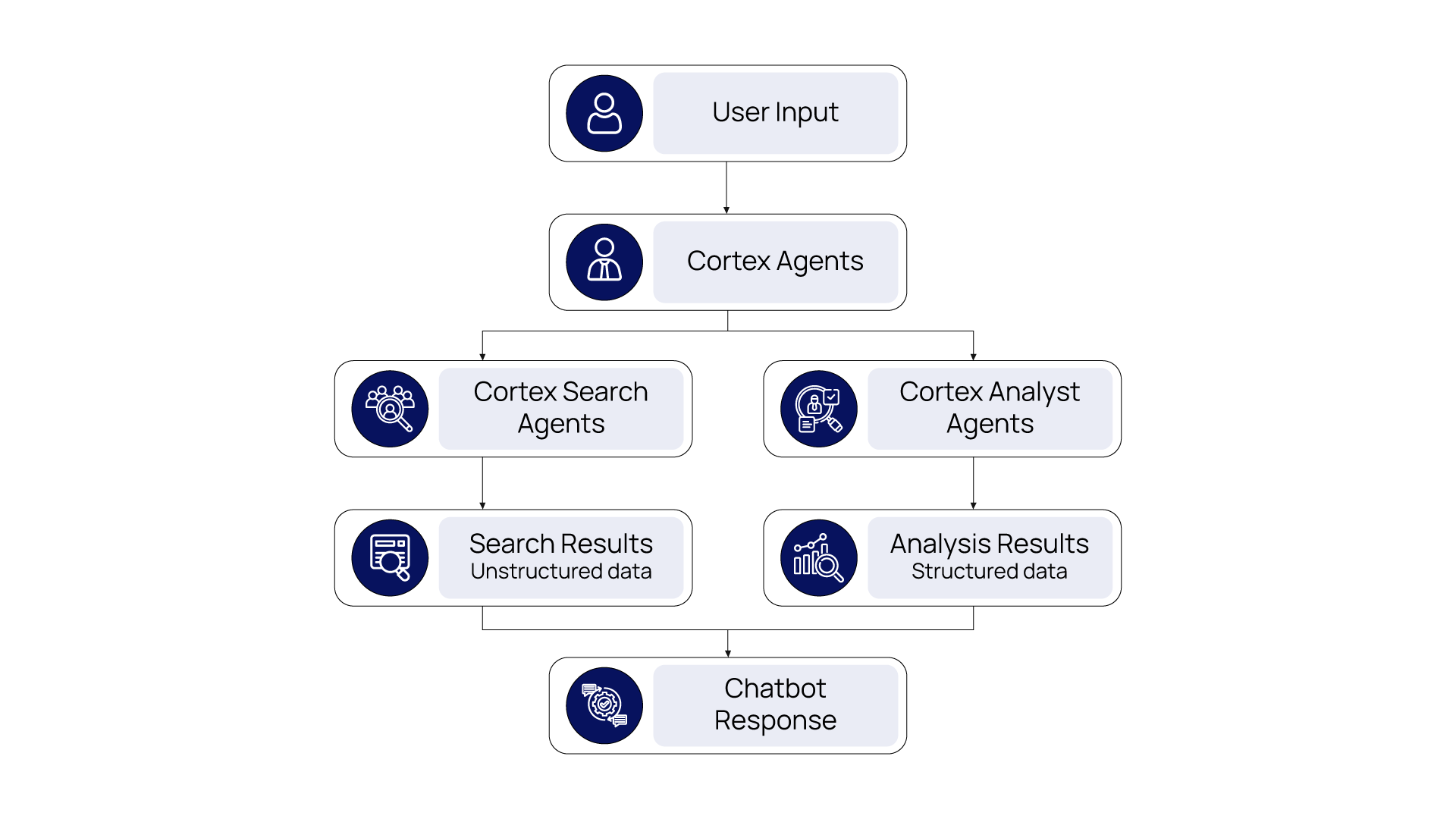The rapid evolution of AI has brought forth a transformative paradigm—agentic AI.
Unlike traditional AI models that perform tasks based on direct input and limited context, agentic AI introduces autonomous, goal-driven systems capable of reasoning, decision-making, and executing complex workflows with minimal human intervention.
These agents can plan, monitor, and adapt their actions based on changing environments and objectives. Inspired by cognitive science and automation, agentic AI systems emulate human-like problem solving and task execution by breaking larger goals into sub-tasks and coordinating their resolution.
Understanding Data Intelligence: What’s in it for Enterprises
Data intelligence (DI) is a comprehensive approach that combines effective enterprise data management with advanced analytics. It helps businesses turn their data into useful information that supports smarter decisions and better actions.
Instead of just reacting to events, enterprises can use artificial intelligence (AI) within their data environments to improve how business teams understand patterns, automate processes, and adapt quickly to changes.
This makes enterprise systems intelligent and effective in solving real-world problems.
The Role of Agentic AI in Data Intelligence
As enterprises seek more intelligent systems that can act rather than merely react, agentic AI represents the future, especially in domains where data interpretation, process automation, and adaptive decision-making are crucial.
Introduction to Snowflake Cortex Agents
Snowflake, known for its powerful AI data cloud platform, has entered the agentic AI era with Snowflake Cortex Agents.
Introduced as part of Snowflake Cortex—a fully managed service for ML and AI—Cortex Agents enable enterprises to create intelligent, task-oriented AI agents that operate over structured and unstructured data within the Snowflake ecosystem.
Cortex Agents bridge the gap between natural language interfaces and complex data operations, allowing users to query, analyze, and automate insights directly from their Snowflake data using language models and agentic workflows.
By embedding AI agents directly within the data platform, Snowflake removes the friction of moving data across systems, offering a unified environment for intelligent data interaction.
Cortex Agents are now in public preview.
In this blog, we’ll dive into the latest features of the Snowflake Cortex Agents and explore potential enhancements that could be added in the future.
Understanding Cortex Agents for Data Intelligence
Cortex Agents bring increased autonomy to enterprise data intelligence. Whether used within enterprise analytics initiatives or as a part of everyday tasks for multiple teams with their data and AI platforms, these have a powerful role in driving data to value.
They integrate both structured and unstructured data sources to generate actionable insights. They intelligently plan and execute tasks using specialized tools, ensuring that complex data environments are navigated efficiently.
To achieve this, Cortex Agents rely on two key components:
- Cortex Analyst: Processes structured data by generating SQL queries.
- Cortex Search: Extracts insights from unstructured data sources.
Cortex Search specializes in handling unstructured data, while Cortex Analyst focuses on structured data processing. Let’s dive in.
Cortex Agents Features
Snowflake Cortex Agents introduce a set of powerful features that make it highly versatile and enterprise-ready:
- Natural Language Interaction: Users can converse with the agent using plain English to perform tasks like data queries, summarization, and report generation.
- Task-Oriented Execution: Agents are designed to fulfill multi-step goals, using tools, functions, and reasoning to plan and execute tasks.
- Tool Integration: A Cortex Agent can use built-in tools such as SQL execution, document parsing, and vector search, as well as custom tools defined by the user.
- Contextual Memory: Memory management lets agents track and store conversation history and intermediate steps, making them context-aware and consistent.
- Security and Governance: Integrated with Snowflake’s native security and access controls, ensuring enterprise-grade compliance and data protection.
Cortex Analyst and Cortex Search
Cortex Analyst and Cortex Search work together to enable natural language querying and AI-powered insights across both structured and unstructured enterprise data.
Cortex Analyst
Converts natural language queries into precise SQL using LLMs and semantic models, empowering business users to analyze structured data without coding.
- Natural Language to SQL: Converts natural language queries into SQL for structured data analysis.
- LLM-Powered: Utilizes large language models (LLMs) such as Meta Llama, Mistral, and Azure OpenAI.
- Semantic Precision: Uses semantic models to enhance SQL query precision and accuracy.
- No-Code/Low-Code Friendly: Enables business users and analysts with minimal coding skills to perform advanced data analysis.
Cortex Search
Uses semantic search and chunk-based indexing to extract relevant insights from unstructured data, providing an easy-to-use natural language interface.
- Semantic Search in Snowflake: Enables natural language queries over unstructured data using built-in LLM capabilities.
- Retrieval-Augmented Generation (RAG): Integrates with Cortex Agents to enrich LLM responses with relevant document context.
- Chunk-Based Indexing for Precision: Documents are broken into smaller chunks to improve retrieval accuracy and relevance.
- User-Friendly Query Interface: Allows users to ask questions in everyday language, making it accessible for non-technical users.
Key Components of a Cortex Agent
To understand how a Cortex Agent works under the hood, it’s essential to break down its architecture into key components:
- Agent Definition: Agents are defined by users using a declarative JSON-based format that specifies tools, memory, behavior, and system prompts.
- Tools and Functions: Agents can leverage Cortex Analyst and search capabilities, built-in and custom tools, such as SQL functions, Python UDFs, and external APIs.
- Memory and Scratchpad: The agent maintains memory to store intermediate steps, retrieved documents, and past user interactions, enabling coherent long-form reasoning.
- Execution Engine: This orchestration layer processes user inputs, routes them through LLMs, invokes tools, and generates responses in either a structured or natural language format.
Insurance Use Case: Improved Claims Processing with Cortex Agent
Consider this practical use case in the insurance sector— a claims processing assistant powered by Cortex Agent.
Use Case
Our Insurance client faced a significant challenge in managing the overwhelming volume of documents received daily, which includes both structured data (such as tables and forms) and unstructured data (like insurance forms).
The manual process of extracting relevant information from these documents is time-consuming, error-prone, and inefficient.
To address this issue, the company aims to develop an intelligent agent, “Insurance Assistance Agent,” that automates the extraction of pertinent information from these diverse document types.
How Cortex Agents Simplified Data

- Claims Triage: An agent reads unstructured claim descriptions, extracts entities (claimant name, incident details), and populates structured fields in the database.
- Document Analysis: It parses attached PDFs (e.g., medical bills, police reports) to extract relevant information.
- Fraud Detection: The agent can execute SQL and ML models to flag anomalies in claims based on historical patterns.
- Customer Interaction: It can even generate summaries or responses to claimants, auto-filling reports or emails.
- Audit Trail: With built-in memory, all actions and decisions made by the agent are logged for compliance and review.
By embedding this intelligence directly into their Snowflake data warehouse, insurers eliminate the need to move sensitive data between systems, ensuring efficiency, security, and scalability.
A Quick Glance at AI Advancements in Snowflake
At Snowflake Summit 2025, Snowflake unveiled advancements to simplify, optimize, and secure AI within the Snowflake AI platform. These innovations empower business users and data scientists to derive actionable insights from structured and unstructured data without complex tools or infrastructure, all within Snowflake’s secure environment and unified governance.
What’s New
- Data Agents: Snowflake Intelligence (public preview soon) and Cortex Agents (general availability soon) enable rapid, trustworthy actions from data and automate multistep tasks, integrating with Microsoft Teams and custom apps.
- Cortex AISQL and Analytics: Cortex AISQL (public preview) simplifies AI workflows by integrating multimodal data processing into SQL. It enhances unstructured data insights with features like schema-aware table extractions in 28 languages and improved retrieval via Cortex Search.
- Generative AI and Governance: AI Observability (general availability soon) offers no-code and pro-code monitoring for generative AI apps. Snowflake integrates leading LLMs (e.g., OpenAI, Anthropic, Meta) within its secure perimeter and introduces AI Governance Gateway (private preview soon) for access control, usage tracking, and budget enforcement.
- New Machine Learning Capabilities: Enhanced scalability and flexibility for building and serving production-ready models, including the autonomous Data Science Agent for streamlined workflows.
The Agentic AI Differentiator: Reliable Autonomy with Data Intelligence
The rise of agentic AI represents a significant leap toward autonomous AI systems and operations for enterprises, and Agentic AI, like Snowflake Cortex Agents, leads this transformation.
Agentic AI, integrated with large language models, enterprise-grade data management, and AI’s reasoning features, empowers businesses to achieve unprecedented levels of action-driving insight and automation.
Whether operating in industries like insurance, finance, healthcare, or retail, AI Agents for data intelligence like Cortex Agents will provide the flexibility to create task-specific agents that boost productivity, minimize manual effort, and foster data-driven innovation.
Ready for your next step toward enterprise data intelligence with Snowflake Cortex Agent? Start building intelligent AI workflows today. Learn about our Snowflake partnership and get started now!



















